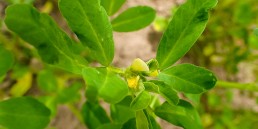Herbal Actions
What is a “herbal action”?
When we speak about the action(s) of a certain plant, we are referring to one or more effects a plant can have on our body. Often these actions are explained in two or three words; however, herbal actions are so much more than that! Since plants are wonderful complex beings, they also have several actions. Most herbs can compliment their action(s) in combination with another herb, basically showing off their best side with the support of a “good friend”. Sometimes they work great on their own, but most of the times, they excel with a good buddy on their side. Think- Teamwork!
Astringents
The Astringent feeling is something you probably can all relate with. If you are unsure, taking a bite out of any unripe fruit or vegetable will quickly remind you what it feels like. Rather swiftly, your mouth will dry out completely and leave you with a very puckering sensation. Another great example is that of black tea, especially one that has been steeping for too long. Why not make yourself a cup and consciously experience the sensation of astringent herbs? Take a sip and leave it in your mouth for about a minute or so. Can you feel how it has affected the mucosal lining, how the tissue has tightened and a very mild analgesic feel is overcoming the inside of your mouth? This is astringency.
Tannins
This dryness you experienced is the result of tannins, found in astringent plants. Tannins are a subcategory of phenolic compounds. Back in the day, tanning leather with astringent plants was very common practice. Animal skins were often preserved with Oak bark, Walnut shells and other specific tree barks. Nowadays, leather is mostly tanned with mineral salts and other inorganic substances. However, the term “tannin” comes from its traditional usage for tanning leather.
I always like to find out “why” a certain plant is high in a certain constituent.
Plants high in tannins (often found in the bark, roots and also leaves) protect themselves internally from different kinds of funguses as well as protection from mold; they are helpful for the plant to prevent water, bacteria or other pests to enter. Externally they serve as protection from loss of fluid from the plant itself. Aren’t plants amazing??
How Astringents Work
Traditionally, astringents are used to treat tissue states.
Herbalist David Hoffmann writes that tannins have a lot of benefits, including:
- Reducing irritation on the surface of tissues through a sort of numbing action
- Reducing surface inflammation
- Creating a barrier against infection, which is of great help for wounds and burns
Astringency also dries up extra moisture in the body. This can be helpful for a cold, wet gut or diarrhea.
Where the energetics are mostly plant specific, it can be said that astringents are cool and dry (with exceptions of course). Therefore, astringents are best suited for damp conditions.
Astringents and the Body
So, let’s get into how astringent herbs can be useful for our body.
By tightening the upper layer of the skin, tannins make it hard for germs to enter the body via the skin. In case of a bleeding wound, astringents can constrict blood vessels to help staunch it. In this case, we call the action styptic. Due to the astringent and mildly analgesic actions, astringents work great to soothe a sunburn or other mild burn.
Examples of Some Astringent Herbs
- Achillea millefolium (Yarrow), Arnica montana (Arnica) as well as Quercus spp. (Oak) are all great astringents for the skin.
- Rubus fructicosus (Blackberry) root seems to be well known for its high amounts of tannins and is a strong remedy for both diarrhea and dysentery.
Wonderful herbs for the digestive tract include:
- Rubus fructicosus (Blackberry)
- Filipendulum ulmaria (Meadowsweet)
- Salvia officinalis (Sage)
Astringent herbs are frequently used to address urinary incontinence, bedwetting, and are an important part of urinary tract infection treatments.
Specific herbs for the urinary tract include:
- Equisetum arvense (Horsetail),
- Achiella millefolium (Yarrow)
- Cyanococcus (Blueberry leaf).
If you have experienced pregnancy, chances are you drank lots and lots of Rubus ideaus (Raspberry leaf) tea. This nutritive astringent tonic is great to strengthen the uterus and get it in “top form” for delivery – and back into form, after delivery. Rubus ideaus is a wonderful herb for the reproductive system.
I hope this post gave you a little insight on Astringents and how they can interact with our body. This topic is covered much more in depth in the herbal course, which is currently developed and coming soon by our group of wonderful herbalists.
Resources:
Besides my own words, this write up features information from the following resources:
– Ursel Buehring Praxis- Lehrbuch Heilpflanzenkunde – Grundlagen – Anwendung – Therapie. 4 ueberarbeitete Auflage. Karl F. Haug Verlag in MVS Medizinverlage Stuttgart GmbH & Co. KG’ 70469 Stuttgart, Germany. 2014. (Published in German language)
– Jim McDonald – Foundational Herbcraft – www.herbcradft.org – collected writings from www.PlantHealkerMagazine.com.
– David Hoffmann – Medicinal Herbalism: The science and practice of herbal medicine. Healing Art Press, Rochester, Vermont 05767. 2003.
– Abrah Arneson – The Herbal Apprentice: Plant Medicine and the Human Being – Green Heart Press. 2014.
– Matthew Wood – The practice of Traditional Western Herbalism – Basic Doctrine, Energetics and Classification – North Atlantic Books, Berkley, California. 2004.
– Lisa Ganora – Herbal Constitiuents: Foundations of Phytochemistry – Herbalchem Press, Louisville, Colorado. 2009
Evelyn Mueller
I am a community herbalist based in Ontario, Canada, and a graduate of The Ginkgo Tree Herbal Course and founder and creator of ‘The Lion’s Tooth’: a 12 month program to help families re-connect with nature and use plants like their ancestors did. It is my mission to share the wonders nature provides for us, to establish meaningful relationships between humans and plants as well as to help awaken our embedded instincts and use those to nurture and heal our body, our mind and our wonderful earth.
Subscribe to Blog via Email



